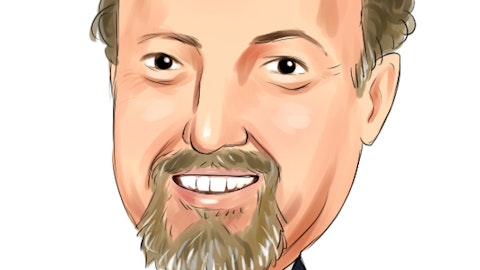Richard B. Cohen: Yes. So, BreakPack may have impact in 2024, right at the end of the year. So, in the last quarter, if it does, because of just the cycle of selling, and so that would be one. Ambient, we’re actually piloting some, perishable testing in a perishable warehouse as we speak. So, I think, that could be, I would say, probably not this year, but I would say 12 months from now just from the cycle. But we will be able to offer perishables and then after that would be frozen. But the first go around would be stuff like dairy, produce and meat, which is around 32 degrees. And then after that, we would develop a system for minus 20.
Carol Hibbard: And then Matt, I’ll just add to that. BreakPack, our proof of concept is already contributing to revenue this year, and has been over the past year.
Matt Summerville: Yes.
Carol Hibbard: And so our product mix that we have in flow is also is already a revenue contributor. Now, in terms of what we’re able to add to that as we continue to offer it, you’ll see that grow as we expand that at the end of ‘24.
Matt Summerville: Yes. Understood. Thank you. I was aware of that, but thank you for, yes. Thanks for clarifying.
Carol Hibbard: Yes.
Matt Summerville: I should have stated it a little differently. Thanks, guys.
Richard B. Cohen: Yes, you too.
Operator: Thank you. One moment, please. Our next question comes from the line of Mark Delaney of Goldman Sachs. Your line is open.
Mark Delaney: Yes, good afternoon. Thank you so much for taking the questions. If I heard correctly, Carol, you mentioned stabilizing temporarily the number of system starts. And if I heard that correctly, I’m hoping to better understand the thought process and how you’re thinking about managing the company operationally, especially with the company adding more outsourcing and manufacturing partners, I would have thought there had been some potential to increase the number of starts the company was doing?
Carol Hibbard: Yes. Thanks for the question, Mark. You’ll see that by stabilizing. So last quarter, we introduced four new systems into the quarter, this quarter you’re seeing five. By stabilizing, we indicated don’t expect that continue to grow to six to seven to eight every single quarter, but we will see improved number of systems as we grow over the next couple of years. When you think about what we already have in our backlog, the other comment related to that stabilizing is you’re going to start seeing us delivering on our systems with the backlog that we currently have. And so we’re going to continue to ramp the number of systems that we turn operational every quarter, and then the number that we continue to add from either new customers expect a new customer one to two every year as we’ve indicated in the past, there’s really no change to that.
And then as we expand into GreenBox, in the ‘24 and ‘25, I think that’s when you’ll really start seeing the additional ramp.
Mark Delaney: Understood. That’s very helpful context. And then in the first question about the EBITDA guidance, you mentioned the guidance, assuming the ability and flexibility to deploy resources to support customers, So, I mean, to better understand what you meant by that, is there something with, just some of the more recent projects that’s been more difficult? Or are you more alluding to you’re supporting some newer customers and just wanting to make sure you have the capability to support them in the event, that is, necessary? Thank you.
Carol Hibbard: Yes. Thanks for the follow-up. So, in terms of our guide, when we talk about wanting the ability to, deploy on schedule, we are now in the stage where we have 37 different projects in deployment. So that’s up from 22 a year ago. And so, we are scaling right now. And what we want to make sure we do is that we adhere to schedule and that we’re able to deliver that high quality. So if that means providing a few additional resources or taking a week or two longer, to go ahead and deliver, that’s what you’re going to see in some of what I’ll call the lumpiness, in the next quarter around both revenue and in our margin.
Mark Delaney: Okay. Thank you.
Carol Hibbard: We don’t want to do anything short sighted to save a few points on margin that will help us in the long-term.
Mark Delaney: Understood. Thank you very much.
Operator: Thank you. One moment, please. Our next question comes from the line of Nicole DeBlase of Deutsche Bank. Your line is open.
Nicole DeBlase: Yes. Thanks for the question, guys. Good evening. Maybe just starting with R&D, it’s been on a bit of a declining path for the past few quarters. I guess, why is that? And then, what is the outlook for R&D expense over the next several quarters?
Carol Hibbard: Thanks, Nicole. So, on R&D, I think what you’re seeing when you compare fourth quarter to first quarter, is that additional week that we talked about. So, in the fourth quarter last year, we had a 14-week quarter versus the 13-week quarter. So, we had an extra week contributing to R&D. So, that’s a little bit of a fluctuation from fourth quarter to first quarter. I would expect our R&D to continue to ramp modestly throughout the course of the year, but what we do want to make sure we do is we’re looking at multiple innovation projects. And so we want to maintain the ability to ramp our R&D if those innovation projects come to light and we want to expand that at the back half of the year. So, I’d expect moderate growth, but we are looking at projects that not only drive innovation, but we’re also looking at projects that drive improved efficiency that would help improve our cost structure as well as the operational efficiency on the end customer, for the systems that we deploy.
Nicole DeBlase: Got it. Okay. That’s really helpful. And then, when you spoke about getting to one deployment in the 20 month zone, I guess, what would be the long-term goal of the length of appointment, once you feel good about the whole process? Thank you.
Carol Hibbard: Okay. So, I’ll start and then Rick can chime in, in terms of long-term vision. As we’ve talked about in the past, we expect that 20-month cycle over the long-term to get down to 12-months or lower. So, we’ve talked about the things that we need to put in place to be able to go do that. So, that’s from a long-term perspective. I think one of the other things to think through is what really enabled that 20-months, that might be one of the questions, so that we can make sure we’re looking at how do you enable that going down to 18-months and then to 16-months. So, a couple of things enabled us hitting that achievement this quarter. One was, we now have continuous learning over multiple deployments. So, our outsourcing partners, they’ve now got multiple deployments under their belt and they’re improving on each one.
We’ve also got increased collaboration from our entire deployment team. So, our deployment team includes Symbotic resources, our suppliers, as well as our customer. And we’ve really seen an increase in that collaboration over the past quarter. And then the last one is the quality and standardization of what I’ll call the build. So, our build instructions, our test procedures, we’re standardizing that more and more from deployment to deployment, and that’s really enabling the improvement from our partners.
Nicole DeBlase: Thanks. That was super helpful. I’ll pass it on.
Carol Hibbard: Thanks, Nicole.
Operator: Thank you. One moment, please. Our next question comes from the line of Chris Snyder of UBS. Your line is open.
Chris Snyder: Thank you. I wanted to follow-up on the communication earlier around accelerating or picking up growth investment to drive or help facilitate the accelerated growth. And when we look at OpEx, over the last four quarters, OpEx has generally been sideways and the number of projects in process and the revenue has gone up 40%. So I guess, is there something that’s happening now that’s causing this, the OpEx meeting to pick up into Q2, because we’ve seen so much growth already without that. So, finally, I guess the question is why now?
Carol Hibbard: Yes. We continue to modulate our OpEx because we’re getting better on that spend. But I think you’re going to see the improvement on that is where, we’ll continue to grow OpEx, but it’s not going to grow nearly at same level of our revenue because we’re also getting improvements on our spending as we do that.
Chris Snyder: Okay. Fair enough. And then I wanted to talk about or follow-up on about the non-ambient food opportunity. Specifically, if we think about, the existing customers that the company has, is there any way to frame the size of the opportunity from non-ambient food with those existing customers? And then also, when you see the Walmart backlog, does that include any revenue for, systems related to non-ambient food? Thank you.
Richard B. Cohen: The Walmart backlog does not include any systems that are non-ambient. So, obviously and none of our other customers, whether it’s C&S or UNFI, also, there’s no — we weren’t selling non-ambient. But in the future, we’ll be able to and we think that’s a big market. It’s a slightly different market because there, this is a market where, and when we’re focused on ambient, we’re really focusing on one, we can obviously build pallets, but building in a perishable warehouse, the space is just so expensive. We’re actually working on increasing the density of our system, which may help us across a number of areas. But it’s, I can’t give you a number for the market, but it’s a big market.
Chris Snyder: Thank you.
Operator: Thank you. One moment, please. Our next question comes from the line of Jim Ricchiuti of Needham and Company. Your line is open.
Jim Ricchiuti: Hi. Thank you. Rick, question just on BreakPack. You alluded to the drugstore business. How important is it to you to get a use case outside of your large customer for BreakPack in a market like that?
Richard B. Cohen: Oh, it would be great. I mean, that’s one of the things that I’ve spent a lot of time on is figuring out who are the best use cases, who are the logical customers for what we’re doing. And one of the things that we find, and we’ve been pretty busy. So, we haven’t been doing a tremendous amount of marketing because we’re very focused on delivering for the customers we have in place. But one of the things that we do when we bring a new customer to the market just to see a site, is many times their response is, I didn’t even know this was possible. So, that’s why we’re very, very focused on delivering on time, delivering with a braggingly happy customer expectation, and we’re going to focus on that for the rest of this year.




